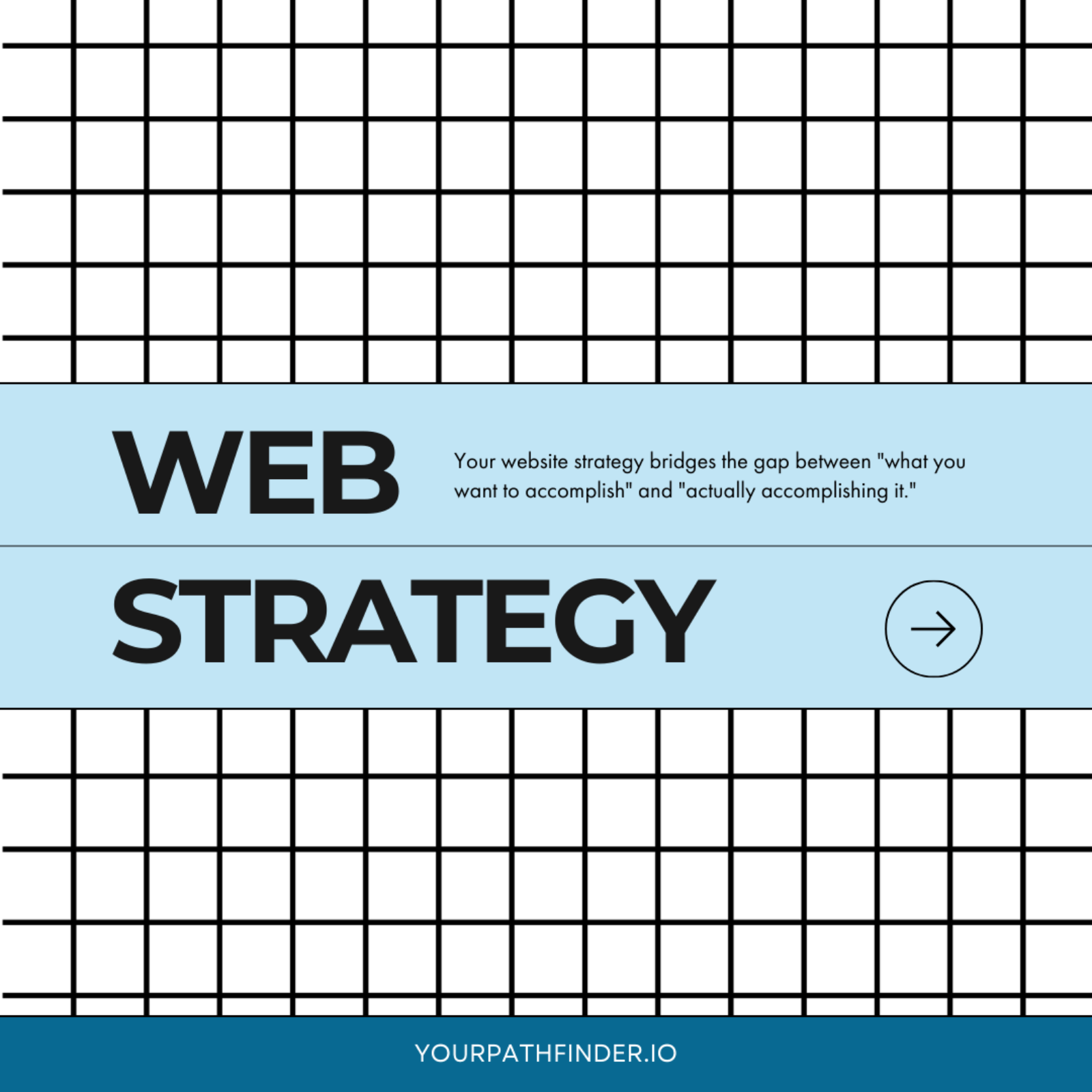10 Things You Need For A Strategic Website
You might think building a website is as simple as choosing the right colors, fonts, and layout, but there’s a lot more to it than that. When it comes to building a strategic website – planning is key!
Creating a website strategy might seem easy enough, but it’s all about the amount of effort you put in. The more time you take to detail and create a comprehensive website strategy, the easier it’s going to be to build and launch your website.
Your website strategy is where design meets function. It goes far beyond the trending style and deep into the intelligence of your website. Because any well-designed website can fail miserably behind the scenes.
What’s In A Website Strategy?
Your website strategy bridges the gap between “what you want to accomplish” and “actually accomplishing it.”
A website strategy is essentially a long-term business plan that’s built around your website. Your website strategy goes beyond the design you choose for your website – it helps inform the content you create, your marketing efforts, and more.
Your website strategy involves setting goals, defining your target audience, creating a branding strategy, and using keyword research and search engine optimization (SEO) to optimize your content while you build your website.
All of these individual parts work together to help you design and develop an effective website, making it easier to optimize your website in a way that’s aligned with your goals. Your website strategy can also help with the basics of branding, including your brand’s personality, appearance, and purpose.
Start Here
With a little time and effort, you can create a website strategy to help you build the best website for your brand. Let’s dive into those steps!
Set Your Goals
No good plan is complete without goals, so take some time to set a handful of goals for your website.
What are you trying to achieve with the new website or redesign? What is the website’s main purpose? That function may be to sell products, to deliver informational content, to entertain, to inform or to provide access to a service. Whatever that function is, your website (design and function) must focus on fulfilling it.
Goals are also important, especially if you’re doing a redesign. Ask why you are doing the redesign: are you looking to grow the number of sign-ups, decrease the bounce rate or maybe increase user participation?
And set SMART goals. SMART stands for:
- Specific
- Measurable
- Attainable
- Relevant
- Time-Bound
The goals you set will determine what you’re working toward with your website strategy – so think intentionally.
Find Your Story
Every brand has a story to tell, so find your story and figure out how you want to tell it. This creates an opportunity for companies that want to build strong relationships with their audience.
Every piece of your strategy and branding as a whole, should revolve around that story. Be consistent, be cohesive, be intentional.
Good stories surprise us. They make us think and feel. They stick in our minds and help us remember ideas and concepts in a way that a PowerPoint crammed with bar graphs never can.
Shane Snow, The Storytelling Edge
Learn more about building your brand story on the Semrush blog:
Know Your Target Audience
One thing you need to do is decide on the right target audience for your website. Every business targets a different specific demographic, so it’s strategic to figure out who uses your products or services. The easiest way to do this is to look at any existing data you may have about your customers, including their age, location, and other information that allows you to segment your target audience.
As yourself: What is my ____ for? Who needs my ____? Why do they need ____? Who fits these profiles? What do they need to see to be convinced to buy in?
You can also research your niche and industry. Who is following your competitors? Who is using their products or services?
Take Inventory Of Your Content
Content is essential if you want to drive more traffic to your website and convert website visitors into customers.
Before you launch your website, figure out what kind of content you have to offer. You’ve probably got a basic story about your brand, but do you have any videos, testimonies, or blog posts that you’re ready to share?
Knowing what you already have will help in building out your full website content later.
If you’re using content that was written or created previously but not published, you can always add some relevant keywords to help increase your search engine rankings.
Research Keywords
Before you start planning or writing any new content, use keyword research tools to figure out what relevant keywords you want your business to rank for. By using certain keywords in high-quality content, you can increase your search engine rankings when people search for that keyword. These keywords may change from time to time, so it’s smart to check out keyword rankings on a somewhat regular basis.
Keyword Checklist:
- High search volume
- High relevance
- Strong conversion value
- A bit of competition
Plan + Write Content
Now that you know what keywords you want to use in your website, you can start planning and writing content. When you’re planning out content for your website, aim to use your keyword about once or twice per 100 words. If you create a website strategy that involves using keywords more than that, you may end up being penalized for keyword stuffing.
A good-looking page isn’t necessarily a successful one. There needs to be a point to every page, and a focus for every element on it in order to drive your target user action. What is the main thing you want someone to do on that page? A key page strategy helps you define that, and plan how to make it happen.
If you want to keep things fresh, mix it up with different types of content for your readers. Short-form blogs can be a good way to share basic information, while long-form posts allow you to take an in-depth look at topics and provide more value to readers. You can use a portfolio page that showcases your work in a visual way, but also ties back to your service pages with a more in-depth dive to what you offer. Your product pages can also include video and customer testimonials. If pages seem a bit too overloaded, break it up with images, blocks, accordion style content, etc.
Develop Your Brand Style
A lot of designers tend to get a little too inspired by the latest trends and then implement them without thinking first about what sort of image they really should be conveying. Glossy buttons, gradients and scrolling animation may work for some websites, but they may not be right for your brand.
Think about color. Think about the feel you want to achieve and emotions you wish to elicit. Your design should embody the personality and character of your brand. Everything has a brand; even if you don’t sell a product or service – for example, if you run a blog – your website still has a certain feel that makes an impression on your visitors. Decide what that impression should be.
Plan Out Your Website
Once you’ve figured out the basics, take some time to plan out your overall website layout. There are a lot of decisions to make when you’re building a website, including choosing between a static and dynamic website, deciding on a responsive or adaptive design, and deciding on a budget for your project.
During this planning process, you can also work with a web designer to start mocking up a rough draft of your website. You don’t have to keep your website design the same from start to finish, but having a plan to build off can be a big help when filling in all of the above.
Working with an experienced team also gives you a sigh of relief in figuring it all out on your own.
Build Your Strategic Website
The next step to creating a website strategy is to actually build your website. You can’t monitor performance or add new content until you launch your website, so connect with a web developer or use a website builder to get started.
Analyze Your Results Over Time + Adjust Accordingly
Your website probably isn’t going to do very well if you’re not using analytics in some way. You don’t have to be a completely data-driven company, but you do need to monitor things like monthly website visitors, monthly unique visitors, bounce rate, where visitors are coming from, and more. Understanding how your website is performing is essential, even when your site has been live for a few years.
At the end of the day, you’re probably not going to create a perfect website strategy the first time around. The good news is that you can make small adjustments to your website based on analytics and what you learn from operating your website. Perhaps you want to shift your website to focus more on the blog, or maybe you want to create more of an e-commerce website. You may even need to switch up your keywords to rank for something more relevant. Whatever the case may be, there’s no shame in going back and making changes to your website strategy.
Let’s Build Your Strategic Website
Now that you know how to create a website strategy, it’s time to put your strategy into action. From start to finish a website strategy will set you and your business up for success!
With Pathfinder, building a quality website is easy – because we do all the leg work. While keeping your story and mission at the center, we revolve every step around strategically showcasing your business.










